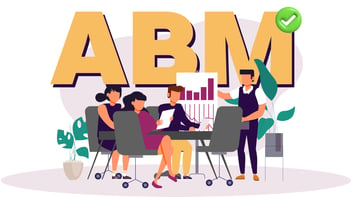
Is Demand Generation Inbound or Outbound? Know the Basics
The battle for customer attention and engagement continues to intensify in the vast and ever-evolving demand generation world. As you strive to reach your target audiences and drive revenue, a crucial strategy known as demand generation, or demand generation, emerges as a critical driver of success.
But is demand generation an inbound or outbound approach? Being an industry leader in demand generation services, we always answer this question to our prospects.
In this article, we will delve into the definition of demand generation and explore its importance in the realm of business-to-business (B2B) marketing. Join us as we unravel the intricacies of the demand generation framework and shed light on its vital role in driving growth and success in today's competitive marketplace. So, let us get started with our demand generation guide.
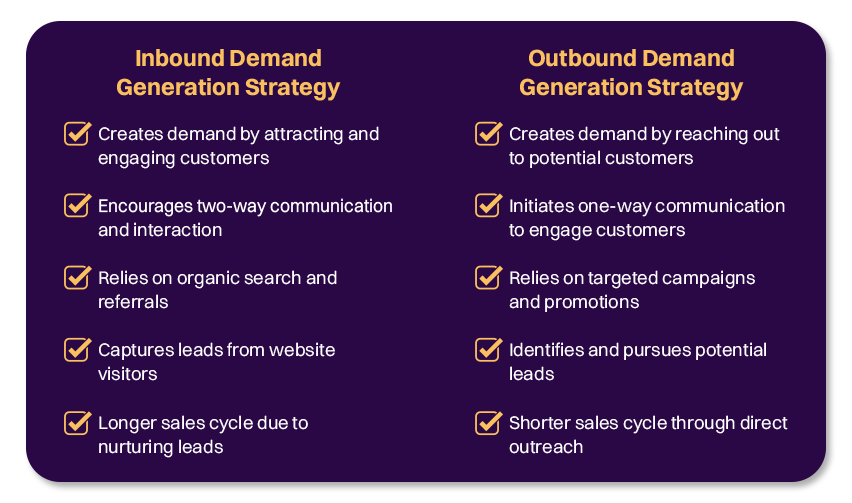
Is Demand Generation Inbound or Outbound?
The question of whether demand generation is inbound or outbound is complex. Instead, the demand generation journey starts with demand creation and ends with demand capture.
You must be wondering isn’t demand generation same as lead generation.
The answer is NO! Lead generation is a tiny part of demand generation.
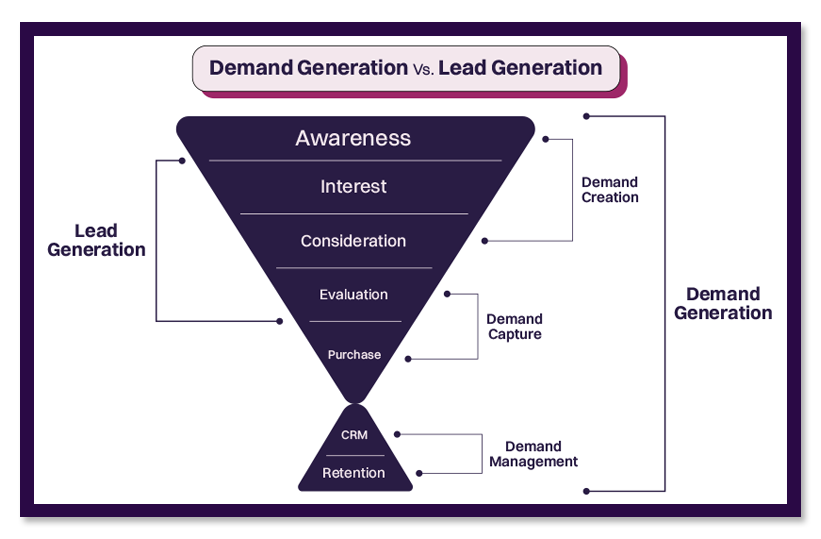
Now, coming to the main topic.
Demand generation is a comprehensive approach incorporating inbound and outbound (online and offline) elements. It encompasses a range of strategies and tactics aimed at generating interest, creating awareness, and driving customer action.
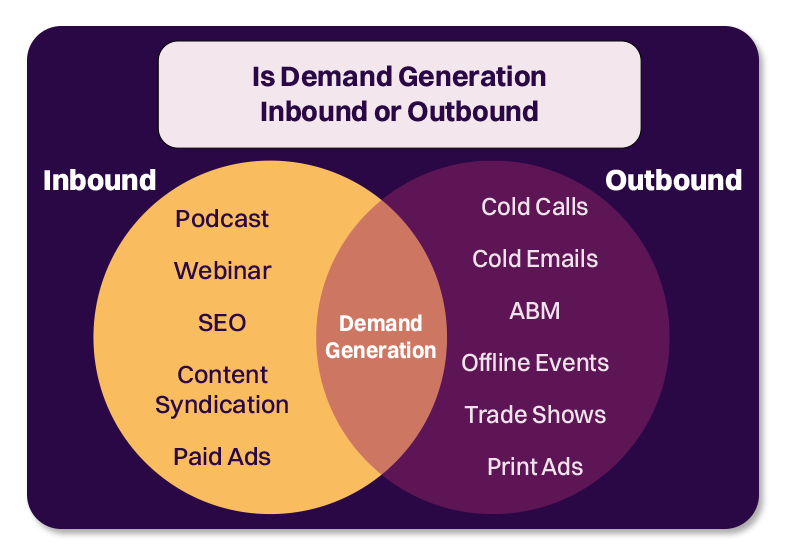
From content marketing and social media engagement to email nurturing and targeted advertising both online and offline, B2B demand generation practices utilize a variety of channels and methods to attract, engage, and convert leads.
So, let us check how B2B demand gen strategies overlap with both approaches.
1. Inbound Demand Generation
It is a customer-centric approach focusing on organically attracting and engaging prospects. It is based on providing value to potential customers through relevant and helpful content. The inbound approach aligns with the buyer's journey, addressing their needs and pain points at each stage to guide them toward purchasing.
A. Characteristics Of Inbound Demand Generation
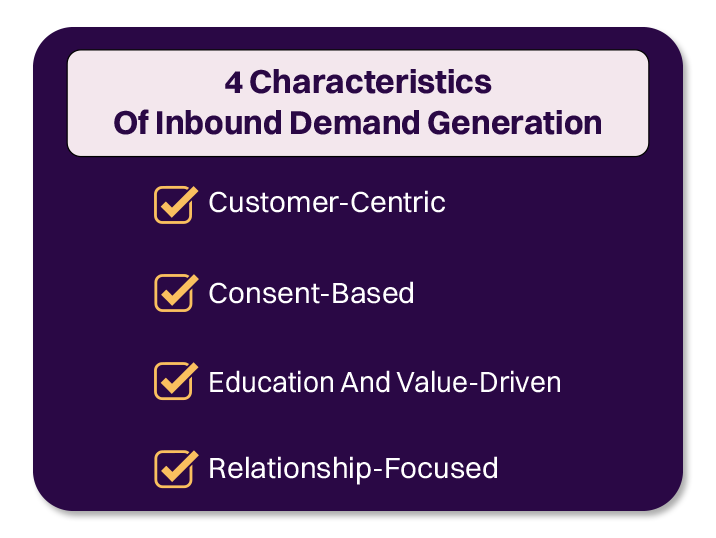
a) Customer-centric: Inbound demand generation puts customers at the center by understanding their needs and providing valuable content to address them.
b) Consent-based: It relies on gaining the consent of prospects to engage with them through opt-ins, subscriptions, and content consumption.
c) Education And Value-driven: It emphasizes providing informative and valuable content to educate and assist prospects in decision-making.
d) Relationship-focused: It aims to build and nurture long-term relationships with prospects by providing ongoing value and personalized experiences.
B. Strategies And Tactics Used In Inbound Demand Generation
This approach utilizes a range of strategies and tactics to attract and engage prospects organically. Here are five commonly used inbound demand generation tactics:
a. Blogging: Creating and maintaining a blog is a fundamental inbound demand generation tactic. Blogs provide a platform to share valuable and educational content related to the industry, products, or services. By consistently publishing high-quality blog posts, you get the following benefits:
- Attract organic traffic
- Establish thought leadership
- Engage with their target audience
b. Search Engine Optimization (SEO): SEO optimizes website content and structure to improve visibility and organic search rankings. It requires you to:
- Conduct keyword research
- Optimize on-page elements
- Build high-quality backlinks
c. Content Offers: Content offers provide valuable resources to prospects in exchange for their contact information. These include:
- E-books
- Whitepapers
- Guides
- Case studies
These offers help capture leads and provide an opportunity to nurture prospects further through targeted email marketing campaigns.
d. Social Media Marketing: Social media platforms offer a powerful channel for engaging with prospects and promoting valuable content. You can attract and engage with your target audience via social media through.
- Creating and sharing relevant posts
- Participating in industry discussions
- Building an active community
e. Email Marketing: Email marketing is a highly effective tactic in inbound demand generation for nurturing leads and building relationships. It lets you deliver personalized and targeted content directly to prospects' inboxes.
Thus, you get to engage with them at different stages of the buyer's journey. Further, it nurtures them towards conversion.
Please note - There’re other methods of inbound demand generation. We have only covered strategies that give significant and long-term results.
2. Outbound Demand Generation
Outbound demand generation is a proactive approach that involves reaching out to prospects proactively to generate leads and drive conversions. Unlike inbound demand generation, which focuses on attracting prospects organically, the outbound approach takes a more direct approach by actively initiating contact with potential customers. It aims to:
- Create brand awareness
- Capture the prospect's attention
- Promote products or services through various outbound channels
A. Characteristics Of Outbound Demand Generation
a. Proactive Outreach: It involves actively reaching out to potential customers through various channels such as cold calls, cold emails, trade shows, industry events, and conferences, etc. It aims to generate interest and initiate engagement.
b. Interruptive: Its tactics often reach the recipient's attention by delivering messages or promotions without their prior engagement.
c. One-way Communication: In outbound demand generation, communication is typically one-way. Marketer delivers messages to the audience without immediate interaction or feedback.
d. Dot Targeting: The outbound approach often targets a very specific audience (dot targeting) to capture the attention of potential customers. However, the target customers may not have actively sought the promoted product or service.
B. Strategies And Tactics Used In Outbound Demand Generation
It utilizes a range of strategies and tactics to reach out to prospects proactively. Here are five commonly used outbound outreach tactics:
a. Cold Email: You can do hyper-personalized cold email campaigns targeting your potential customers who have not previously expressed interest in the product or service. It creates awareness of your brand for that particular audience, captures their attention, delivers a compelling message, and encourages them to take action.
These actions may include visiting your website or scheduling a call with your Sales Development Rep (SDR).
b. Warm Calling: Warm calling is the new cold calling. You make direct phone calls to potential customers to:
- Introduce the product or service
- Deliver a sales pitch
- Generate interest
But before calling any prospect, you should do intense research about each prospect and create a personalized phone script according to your customer profile. This process is called warm calling.
c. Direct Mail: You send physical promotional materials, such as brochures, catalogs, or postcards, directly to potential customers' mailboxes. It lets you capture attention and deliver targeted messaging in a tangible format.
d. Trade Shows and Events: This includes participating in trade shows, conferences, and industry events. Thus, you can showcase your products or services directly to a targeted audience. These events provide you with opportunities to:
- Engage with prospects
- Collect leads
- Network with industry professionals
e) Advertising: It includes traditional advertising channels and digital advertising platforms, such as:
- Television
- Radio
- Print media
- Outdoor billboards
- Display ads
Advertising allows you to reach a broad audience and generate awareness about your offerings.
Using a proper mix of the strategies you can improve your demand generation to a great extent.
Also, you can enjoy the benefits of a demand generation agency by connecting with one. An ideal demand gen agency truly expands your reach and improves your customer base using the above mentioned strategies.
Please note - There’re other methods of outbound demand generation. We have only covered strategies that give significant and long-term results.
Conclusion
So, what's the answer to demand generation inbound or outbound? On the one hand, we can conclude demand generation comprises both inbound and outbound strategies. Inbound demand generation focuses on attracting and engaging potential customers through content marketing, search engine optimization (SEO), and social media.
On the other hand, outbound demand generation involves proactive outreach to target audiences through email marketing, advertising, and direct sales efforts. Ultimately, a comprehensive strategy should incorporate elements of both inbound and outbound tactics to create a demand generation funnel and nurture the demands of your customers effectively.



